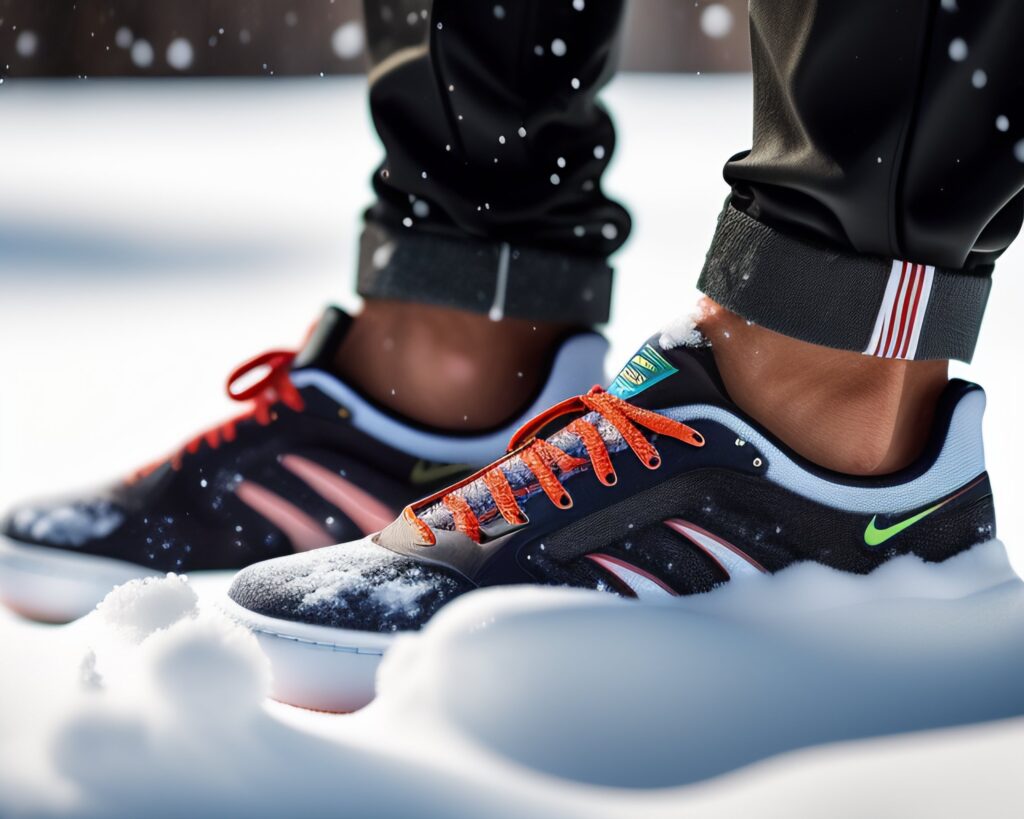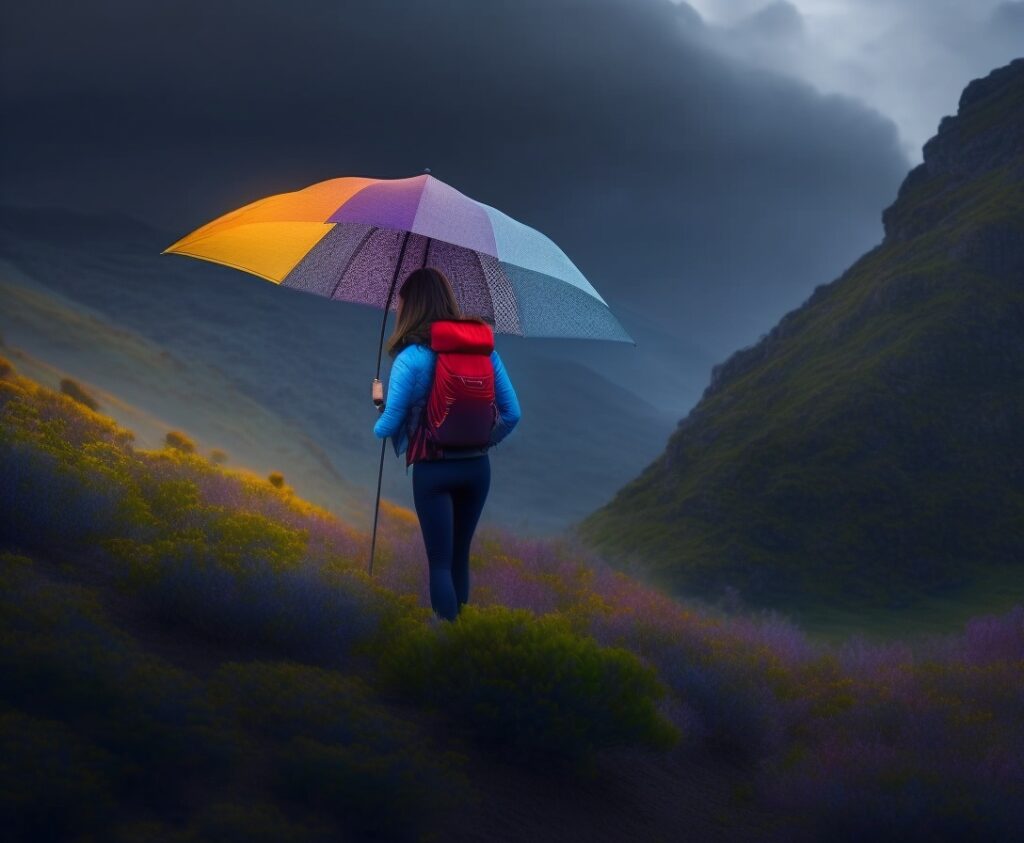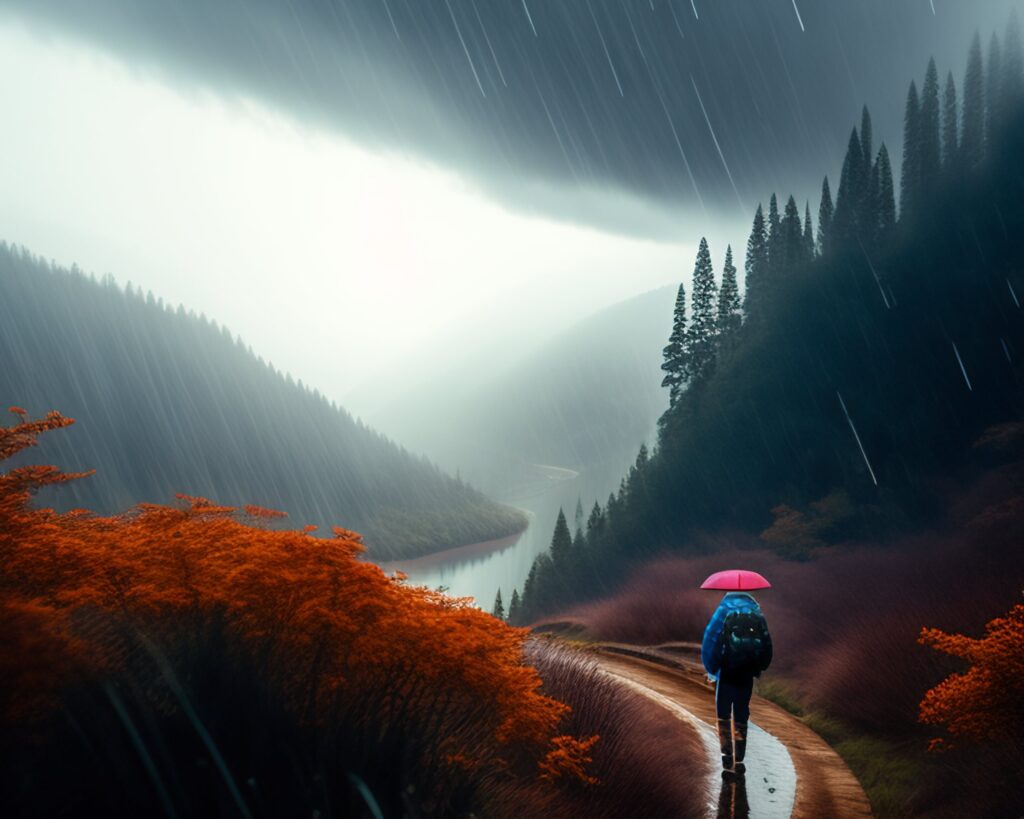Hiking in the rain gear is the best way to embrace nature’s beauty without getting soaked. Hiking in the rain is often seen as a deterrent to many, but it doesn’t have to be! With the right gear, it can actually be a rewarding and enjoyable experience. With proper outdoor gear, hikers will be able to stay dry and comfortable and enjoy hiking in the rain, allowing them to focus their energy on nature, the trail and the journey ahead of them. Not only that, but the additional insulation provided by rain gear will help keep them warm and safe in wetter weather. Whether you’re an experienced hiker or just starting out, investing in quality rainwear comes with a range of benefits that make it worth the purchase.
Benefits of Hiking in the Rain
Hiking in the rain can be a fun and rewarding experience. For starters, it can help keep you cool during hot summer days while still allowing you to get out and explore nature. But there are plenty of other benefits too.
When you’re equipped with the right gear, you’ll stay dry and warm no matter how wet it gets. This is especially important if you’re spending a night in the wilderness. Wearing rainwear such as raincoats, waterproof hiking boots, and pants can help protect you from getting wet in rainy conditions. This can be important as being wet can make you more susceptible to hypothermia and other cold-related health problems. Wearing protective rainwear can help to reduce the amount of exposed skin and prevent insect bites or stings.
The most obvious benefit, however, is that rain-proof gear usually keeps your pack and belongings dry so you don’t have to worry about your phone or other items getting soaked.
Rain-proof gear, such as rain covers for backpacks or waterproof bags, can help to protect your belongings from getting wet in rainy conditions. This can be particularly important for electronics like phones or cameras, which can be easily damaged by water. By keeping your items dry, rain-proof gear can help you avoid the inconvenience and cost of replacing or repairing water-damaged items.
While not everyone will choose to go out in bad weather, those who do enjoy the satisfaction of conquering the elements, being able to take on a whole new challenge, and enjoying the beauty of nature even in the rain.

Buying or Making Hiking Rain Gear?
When you’re contemplating purchasing rain hiking gear, you will have to decide between buying it or making it. Both options have pros and cons and it can be difficult to know which way to go.
Buying ready-made rain gear is a great option for those looking for convenience and simplicity. You can find a variety of styles, colors, and materials and there are plenty of online stores as well as brick-and-mortar locations that offer these items. The downside of buying rain gear is that you may have to pay a higher price due to the convenience factor and you won’t be able to customize it.
Making your own rain gear is a great option for those who are handy and want something custom tailored. This option allows you to choose the fabric, the features, and the overall design of your rain gear. You can make sure that your rain gear fits you perfectly and you will also be able to save some money on materials since they are available at a much lower cost. The downside is that it may take some time to make the rain gear and it may require some skill and experience.
Regardless of your decision, it’s important to consider both options before making your purchase. Both have their benefits and drawbacks, so you should really think about what is best for your needs before making a commitment.
Rain Wear Material
When facing wet weather, the most important thing is to make sure you’re wearing the right kind of material. Breathable materials are key to keeping you dry and comfortable while navigating a rain-soaked trail.
Breathable materials are designed to allow moisture, such as sweat, to escape from the body, while also preventing rain or other external moisture from getting in. This can help to keep you dry and comfortable while hiking in rainy or wet conditions.
Water-repellent fabrics prevent water from seeping in and keep your skin dry. Make sure your clothing is made with waterproof materials, such as nylon or polyester, so you can stay comfortable and dry in any weather.
Fabrics such as Gore-Tex and eVent are waterproof and breathable which helps you keep dryer for longer. They are also lightweight fabrics which makes them perfect for hiking since they don’t add too much extra weight. They are also treated with a Polyurethane coating that gives them their water-resistant properties.
Neoprene is another great fabric that is both waterproof and insulating. It traps body heat, allowing you to stay warm in colder and wetter conditions. It is also easy to clean and dry quickly, making it great for hikes in any kind of weather.
Elastic Cuffs and Ankles – Keeping Out Rain and Snow

It’s not enough just to have waterproof materials when hiking in the rain, you need to make sure your cuffs and ankles are also waterproof. The cuffs and ankles are like doors that need to be closed so that snow or rain can’t get in. With elastic cuffs and ankles you can seal yourself up for maximum protection from the wet. You could also use gaiters to add extra security.
Elastic cuffs and ankles are especially important when dealing with snow. The colder temperatures in the winter season can make the snow harder and crunchier than usual, so having a good elastic cuff can help keep out the snow from getting into your clothing or shoes. Elastic cuffs and ankles can also help keep out rain, which can still be heavy even in the summer months.
When shopping for hiking in the rain gear, make sure you look for items with good quality, waterproof elastic cuffs and ankles. Look for ones with adjustable cinches that fit snugly around your wrists and ankles so they can really seal in all your warmth. If you have trouble finding appropriate cuffing and ankle systems on ready-made rainwear, then consider making your own.
Durability: Investing in Quality & Best Rain Gear
Investing in quality hiking in the rain gear is essential if you want it to last you through your hike. While it is true that buying cheaper products results in spending less upfront, you need to consider how long it will last you. Durable rain gear means fewer mendings and replacements and more time out on the trails.
When shopping for hiking in the rain gear, look to see what material it is made from. Invest in items made with materials such as GORE-TEX or polyester, which are both waterproof and lightweight. These materials will effectively keep you dry and protected while still allowing breathability, so you don’t overheat on the trail.
Another important factor to consider when it comes to durability is the seams of the garment. Make sure the garment you purchase has sealed seams, as this helps to ensure that water does not enter through any gaps or openings in the stitching. If you are making your own rain gear, make sure to buy waterproof seam sealant to help keep you dry.
Lastly, avoid garments with lots of exposed zippers and pockets. Not only do these features add extra weight, but they can also easily let water in. When you are out in the rain, zippers and pockets should be completely sealed off, using a waterproof material like GORE-TEX.
Overall, investing in quality hiking in the rain gear is essential for staying dry and safe on the trails. Although there may be an initial cost for the gear, it will be well worth it when you can stay dry and happy on the trails.
Tips for Staying Dry on a Hiking Trip
One of the most important pieces of advice when it comes to hiking in the rain is staying dry. It can be tough to enjoy your hike when you’re drenched in water! Here are some tips that can help you stay dry and comfortable on the trail:
- Seal pockets tightly – Make sure your pocket zippers and fasteners are sealed tight so rainwater can’t seep in.
- Wear Gore-Tex – Invest in high-quality rain gear, preferably made with a waterproof yet breathable material like Gore-Tex.
- Opt for waterproof hiking shoes – Wearing waterproof boots will keep your feet from getting wet and helph keep your feet warm. Make sure they fit snugly to prevent leakage.
- Install a pack cover – Installing a pack cover helps keep your belongings dry while you’re out and about.
- Layer up – Layer up with fleece and synthetic fabrics to trap warmth and insulate yourself from the dampness.
Following these tips can help keep you dry and warm on your hikes. Having the right gear and preparation is the key to making sure you can stay safe and comfortable during your outdoor adventures.
Pack Cover Gear for Hiking
When you’re out in the rain, keeping your belongings from getting wet is crucial. That’s where a pack cover comes in. It’s an additional layer of waterproof material that fits over the top of your backpack, allowing you to protect your gear from the elements. Pack covers typically come in a range of sizes so you can get one that fits your pack perfectly.
However, it’s important to choose the right type of pack cover. If you opt for an all-in-one cover, that means your entire bag will be covered. These are great if you want to keep everything dry. Alternatively, you can choose a pack rain cover that only protects the top of your pack. This type of cover is great if you need quick access to certain items, as you don’t have to unzip the entire pack.
While pack covers are lightweight and portable, they do have a few drawbacks. Since they’re made of thin material, they can tear more easily than other types of rain gear. Additionally, they don’t provide protection from abrasion or drawstring closures, which means you may want to consider a protective bag inside your pack.
Overall, pack covers serve a very important purpose when hiking on wet terrain. They’ll help you keep your belongings dry, so you can focus on enjoying the trail. And with the right cover and a few extra steps, you’ll be prepared for whatever Mother Nature throws your way.

Tips for Rainy Day – Footwear Selection
Choosing the right footwear for a wet terrain is essential for making your hike safe and enjoyable. Waterproof, breathable, and lightweight materials should all be considered when selecting shoes for wet weather.
For starters, make sure your shoes are completely waterproof. This means that no amount of water seeping into them can leave your feet feeling uncomfortable, or worse, cause blisters. For this, look for shoes made with a Gore-Tex lining or similar waterproof membranes.
In addition to waterproofing, breathability is an important factor to consider. Shoes should allow your feet to “breathe” by allowing moisture and sweat to escape the shoe so your feet stay dry and comfortable even in wet conditions. Look for shoes that are made with mesh panels, synthetic upper materials, and Gore-Tex linings.
Lastly, weight should be a consideration in your footwear selection. Heavier hiking boots can weigh you down and be uncomfortable to wear in wet conditions. Instead, opt for lighter options such as running shoes and trail runners as they provide good grip and traction without the extra bulk.
Choosing the right footwear for wet terrain can make all the difference for your hike. Quality shoes that provide waterproof protection, breathability, and lightweight construction will ensure your feet remain comfortable and dry during wet hikes.
Conclusion
Hiking in wet weather can be a thrilling adventure, with the right hiking in the rain gear and preparation. With quality rainwear on your side, you can stay warm, dry, and safe in any kind of weather. Features like elastic cuffs, breathable materials, and pack covers are all necessary for keeping moisture out. Investing in quality gear ensures durability and reduces the need for mendings and replacements. Lastly, proper footwear is essential for keeping your feet dry and comfortable while walking on wet terrain.
By following the tips outlined in this guide and investing in the right rain gear, anyone can confidently hike in wet weather and enjoy the trail experience. So, don’t let the rain dampen your spirit and have an amazing time exploring nature in the rain!
FAQs for a Rainy Day Hike
- Q: What are the benefits of hiking in the rain?
A: The benefits of hiking in the rain include staying dry, warm, and safe in wet weather. Additionally, wet weather may offer better views and fresher air. - Q: Should I buy or make my own hiking in the rain gear?
A: This depends on your budget, skill level, and access to materials. Ready-made rain gear is typically more expensive but clearly labeled with water-resistance ratings; handmade rain gear is often cheaper but requires more time and effort. - Q: What types of materials should I look for when buying hiking in the rain gear?
A: Look for breathable and water-repellant materials such as nylon, polyester, and Gore-Tex. Additionally, regular waterproofing treatments are necessary when buying these materials. - Q: How are elastic cuffs and ankles important for keeping out rain and snow?
A: Elastic cuffs and ankles prevents leakage by creating a snug fit that wraps around wrists, ankles and waist. This way, water, snow and mud are kept out while still allowing full range of motion. - Q: What should I consider when investing in quality rain gear?
A: High quality rain gear is usually pricier than its low-end counterpart; however, investing in quality gear translates to fewer mendings and replacements in the long run. - Q: What tips do you have for staying dry when hiking in wet weather?
A: Some tips for staying dry in wet weather include sealing pockets tightly, wearing a hat and hood, and opting for waterproof, breathable materials like Gore-Tex. Additionally, using a pack cover is essential for keeping from getting wet. - Q: What should I consider when selecting my footwear for wet terrain?
A: Selecting proper footwear is essential for any outdoor activity, especially for wet terrain. Look for high-top boots or shoes with waterproof material – such as leather, nylon, and Gore-Tex – and heavy-duty rubber soles that provide more traction on wet surfaces.